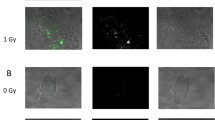Abstract
The efficiency of mitomycin C or gamma rays to induce SCE in early or late G1 was determined in synchronized murine salivary gland cells in vivo, as a measure of the capacity of this tissue to repair the lesions involved in SCE formation before S. The SCE frequencies induced by MMC in the first division (before BrdU incorporation) were significantly lower in the early G1 compared to the late G1, indicating some repair of SCE-inducing lesions. In the second division (after BrdU incorporation), there was no difference between SCE induced in early and late G1, indicating that MMC-induced lesions in such conditions are very persistent and not repairable during G1. The radio induced SCE frequency at early G1 was significantly lower than that observed in late G1, in cells irradiated after BrdU incorporation, suggesting that half of gamma ray-induced DNA lesions that elicit SCEs were repaired.
Similar content being viewed by others
Literature Cited
Wolff, S., Bodycote, J., and Painter, R.B. (1974).Mutat. Res. 25:73–81.
Kato, H. (1980).Cancer Genet. Cytogenet. 2:69–77.
Conner, M.K., Cheng, M., and Biegel, J.A. (1984).Mutat. Res. 126:35–46.
Ishii, Y., and Bender, M.A. (1978).Mutat. Res. 51:411–418.
Popescu, N.C., Amsbaugh, S.C., and DiPaolo, J.A. (1985).Carcinogenesis 6:1627–1630.
Stetka, D.G., Minkler, J., and Carrano, A.V. (1978).Mutat. Res. 51:383–396.
Raposa, T. (1978).Mutat. Res. 57:241–251.
Huff, V., DuFrain, R.J., and Littlefield, L.G. (1982).Mutat. Res. 94:349–357.
Latt, S.A., and Loveday, K.S. (1978).Cytogenet. Cell Genet. 21:184–200.
Morales-Ramírez, P., Vallarino-Kelly, T., and Rodríguez-Reyes, R. (1984).Environ. Mutagen. 6:529–537.
Morales-Ramírez, P., Vallarino-Kelly, T., and Rodríguez-Reyes, R. (1988).Environ. Mol. Mutagen. 11:183–193.
Morales-Ramírez, P., Rodríguez-Reyes, R., and Vallarino-Kelly, T. (1990).Mutat. Res. 232:77–88.
He, S.-M., and Lambert, B. (1985).Mutat. Res. 158:201–208.
Nagasawa, H., Fornace, A.J., Ritter, M.A., and Little, J.B. (1982).Radiat. Res. 92:483–496.
MacRae, W.D., MacKinnon, E.A., and Stich, H.F. (1979).Chromosoma 72:15–22.
Lambert, B., Sten, M., Soderhall, S., Ringborg, U., and Lewenshon, R. (1983).Mutat. Res. 111:171–184.
Lambert, B., Sten, M., Hellgren, L., and Francesconi, D. (1984).Mutat. Res. 139:71–77.
Hedner, K., Mitelman, F., and Pero, R.W. (1984).Mutat. Res. 129:71–76.
Linnainmaa, K., and Wolff, S. (1982).Environ. Mutagen. 4:239–248.
Schwartz, J.L., Morgan, W.S., and Wolff, S. (1984).Environ. Mutagen. 6:203–210.
Barka, T. (1965).Exp. Cell Res. 37:662–679.
Morales-Ramírez, P., Vallarino-Kelly, T., and Rodríguez-Reyes, R., (1984). InSister Chromatid Exchange, (eds.) Tice, R.R., and Hollaender, A. (Plenum Press, New York), pp 599–611.
Baserga, R. (1970).Fed. Proc. 29:1443–1446.
Morales-Ramírez, P. (1980).Mutat. Res. 74:61–69.
Morales-Ramírez, P., Mendiola-Cruz, M.T., Vallarino-Kelly, T., and Rodríguez-Reyes, R. (1994).Environ. Mol. Mutagen. 24:89–95.
Goto, K., Akematsu, T., Shimazu, H., and Sugiyama, T. (1975).Chromosoma 53:223–230.
Perry, P., and Wolff, S. (1974).Nature 251:156–158.
Ishii, Y., and Bender, M.A. (1980).Mutat. Res. 79:19–32.
Raith, M., Cremer, T., Cremer, C., and Speit, G. (1984). InSister Chromatid Exchange, (eds.) Tice, R.R., and Hollaender, A., (Plenum Press, New York), pp 181–197.
Carrano, A.V., Thompson, L.H., Stetka, D.G., Minkley, J.L., Mazrimas, J.A., and Fong, S. (1979).Mutat. Res. 63:175–188.
Cassel, D.M., and Latt, S.A. (1980).Exp. Cell Res. 128:15–22.
Ishii, Y. (1981).Mutat. Res. 91:51–55.
Kano, Y., and Fujiwara, Y. (1982).Mutat. Res. 103:327–332.
Kato, H. (1974).Nature 249:552–553.
Natarajan, A.T., van Zeeland, A.A., Vendergaal-Immerzeel, E.A.M., and Filon, A.R. (1980).Mutat. Res. 69:307–317.
Daza, P., Escalza, P., Mateos, S., and Cortés, F. (1992).Mutat. Res. 270:177–183.
Escalza, P., Daza, P., Piñero, J., and Cortés, F. (1992).Mutagenesis 7:137–140.
Russo, A., Dorigo, E., Stocco, A., and Majone, F. (1993).Mutat. Res. 287:275–282.
Morales-Ramírez, P., Vallarino-Kelly, T., and Rodríguez-Reyes, R. (1983).Environ. Mutagen. 2:149–155.
Abramovky, I., Vorsanger, G., and Kirschorn, K. (1978).Mutat. Res. 50:93–100.
Perry, P., and Evans, H.J. (1975).Nature 258:121–125.
Anderson, H.C., Kihlman, B.A., and Palitti, F. (1981).Hereditas 94:41–44.
Renault, G., Gentil, S. and Chouroulinkov, I. (1982).Mutat. Res. 94:359–368.
Fornace, A.J., Jr, Nagasawa, H., and Little, J.B. (1980).Mutat. Res. 70:323–336.
Author information
Authors and Affiliations
Rights and permissions
About this article
Cite this article
Morales-Ramírez, P., Cruz-Vallejo, V.L., Vallarino-Kelly, T. et al. Persistence during G1 of gamma ray- or mitomycin C-induced lesions eliciting SCE in murine salivary gland cells in vivo. Somat Cell Mol Genet 21, 33–41 (1995). https://doi.org/10.1007/BF02255820
Received:
Accepted:
Issue Date:
DOI: https://doi.org/10.1007/BF02255820




